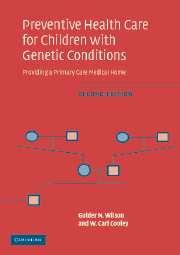Book contents
- Frontmatter
- Contents
- Preface
- Glossary of genetic and molecular terms
- Part I Approach to the child with special needs
- Part II The management of selected single congenital anomalies and associations
- Part III Chromosomal syndromes
- Part IV Syndromes remarkable for altered growth
- 10 Syndromes with proportionate growth failure as a primary manifestation
- 11 Syndromes with disproportionate growth failure (dwarfism)
- 12 Overgrowth syndromes
- 13 Hamartosis syndromes
- Part V Management of craniofacial syndromes
- Part VI Management of connective tissue and integumentary syndromes
- Part VII The management of neurologic and neurodegenerative syndromes
- Part VIII Management of neurodegenerative metabolic disorders
- References
- Index
13 - Hamartosis syndromes
Published online by Cambridge University Press: 29 January 2010
- Frontmatter
- Contents
- Preface
- Glossary of genetic and molecular terms
- Part I Approach to the child with special needs
- Part II The management of selected single congenital anomalies and associations
- Part III Chromosomal syndromes
- Part IV Syndromes remarkable for altered growth
- 10 Syndromes with proportionate growth failure as a primary manifestation
- 11 Syndromes with disproportionate growth failure (dwarfism)
- 12 Overgrowth syndromes
- 13 Hamartosis syndromes
- Part V Management of craniofacial syndromes
- Part VI Management of connective tissue and integumentary syndromes
- Part VII The management of neurologic and neurodegenerative syndromes
- Part VIII Management of neurodegenerative metabolic disorders
- References
- Index
Summary
Hamartomas are overgrowths of normal tissue. They are similar to tumors in their potential for continuous growth and in their lack of normal tissue organization (dysplasia). Hamartomas are different from choristomas, which are composed of tissue that is alien to its body region, and from teratomas, which are true neoplasms arising from embryonic cells. Hamartosis syndromes, epitomized by neurofibromatosis (NF), are characterized by hamartomas, dyshormonic growth, and neoplastic potential (Table 13.1; Jones, 1997, pp. 495–540; Gorlin et al., 2001, pp. 428–93; Roach & Miller, 2004).
In general, hamartosis syndromes affect the central nervous system (seizures, brain tumors, neurosensory abnormalities), oral cavity (tumors, nevi), heart (tumors), skeleton (limb length discrepancies, scoliosis, bony deformities), and epidermis (nevi, café-au-lait spots, surface tumors). Hamartosis syndromes are often associated with high risk of cancer, and produce physical deformities that require supportive counseling and family support. The more common syndromes (Gardner syndrome, NF-1, and tuberous sclerosis) exhibit autosomal-dominant inheritance that is compatible with the causative gene being a tumor suppressor. The cloning and characterization of the responsible gene has provided strong support for this hypothesis in all three syndromes. Since several of the genetic hamartomatous syndromes have high rates of new mutation, it was predicted in the last edition of this book that apparently sporadic disorders such as the Klippel–Trenaunay–Weber or Proteus syndromes (Table 13.1) would prove to be single-gene mutations as well.Mutations in the tumor suppressor phosphatase and tensin homologue (PTEN) gene have been found in patients with a Proteus-like syndrome (Gorlin et al., 2001, p. 481).
- Type
- Chapter
- Information
- Preventive Health Care for Children with Genetic ConditionsProviding a Primary Care Medical Home, pp. 346 - 372Publisher: Cambridge University PressPrint publication year: 2006



